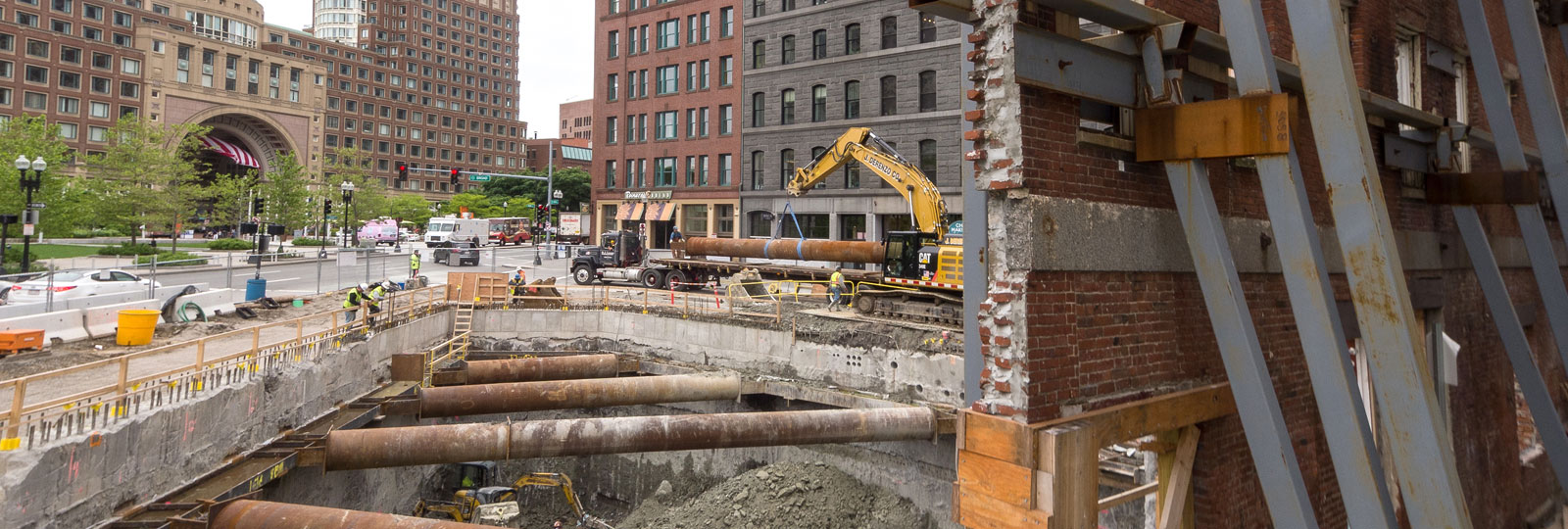A BOSTON LANDMARK RESTS ON SOLID GROUND THANKS TO TREVIICOS EXPERTISE
The construction of a new residential building in Boston’s Custom House Historic District stands out for its incorporation of the exterior walls of an early 19th century warehouse, which were spared demolition during preparation of the site. The historic Bulfinch warehouse at 102 Broad Street was adjacent to a five-story commercial building at 112 Broad Street. While the latter was of no historical value, the former had received landmark status from the Boston Landmark Commission in 1983, proclaiming that the warehouse was “a fine example of commercial architecture in the Federal style”.
When approval was needed for a new 83,500 square foot, 12-story residential building with an extra 3,500 sq. ft. of commercial space and 35 parking spaces below grade, authorities gave permission under the condition that the 212-year exterior designed by architect Charles Bulfinch be preserved. By contrast, the interior had little historical worth as it had been remodeled many times over the years; it proceeded to be demolished, after which a thin wall of 12 inches, in some points 8 inches, was left standing and braced. This original facade will be incorporated in the new building, Boulevard on the Greenway, located at the southeastern tip of Broad Street across from the Surface Artery that runs along the waterfront. Developers of the new residential building are New Boston Ventures and the Construction Managers are Commodore Builders in joint venture with Walsh Brothers, who assigned the foundation work to TREVIICOS, ground engineering specialists based in Charlestown.
The challenge of a small site
TREVIICOS was tasked with constructing the slurry walls on a site whose footprint was roughly 7,100 square feet. The 30” slurry walls developing around the 353 liner feet perimeter was designed to reach 50 feet in depth. Excavation was carried out on a geological profile typical of the Boston waterfront, characterized by urban fill over glacial till, similar to what TREVIICOS encountered back in late eighties when it was involved in the construction of the slurry wall system for the Central Artery Tunnel Project. Unlike that excavation, no major boulders were found at 110 Broad Street; however, all posts and beams left underground for construction of the new tunnel were a challenge and posed a few problems during excavation. Certainly, the biggest challenge was the logistics, as the space to maneuver within the small triangular-shaped site, combined with downtown traffic typical of the area, demanded serious planning on the part of TREVIICOS, who successfully overcame the space restrictions to construct the walls.
Cages for the slurry walls were built off site and trucked in the morning of pour. This meant that the cages could only be the width of trailer, resulting in two or more separate cages per panel, although some panels were single bites with one cage. The slurry wall installation was completed ahead of schedule in 40 production shifts over the course of about eight weeks.
TREVIICOS leaves a footprint in Boston
After two projects completed at the Seaport and a third to be started up, added to the Wynn Casino in Everett, the challenging One Dalton project in Boston, and the Kendall Square project for MIT that recently got underway, TREVIICOS continues to play a prominent role in Boston’s new architectural expansion. As Stefano Valagussa, CEO of TREVIICOS commented, "This year we’re celebrating our 20th anniversary, and being a Boston-based company we are very pleased to be contributing to the city’s new development. Although we have successfully completed dozens of projects around the country, many for the Army Corps of Engineers, we’re proud to have completed yet another project "in town" safely and within the time frame requested."

